Now is the time of mercy (part 1)
What went wrong in the garden and what problem does original sin cause us, and why does what Adam and Eve did affect us? Well let’s look at that familiar story. Adam and Eve are disobedient. Do you recall what happened when they then hear God walking in the garden? Instead of acknowledging their sin, confessing it, and embracing God’s merciful love, they hide. Rather than running to Him, they run away. Rather than trust our infinitely good and merciful God, they are afraid of him.
Truly, sin begins with a lack of trust: “Man let his trust in his creator die in his heart.”[1] Of course, pride was in there, too. But the starting point, the origin of sin, is lack of trust in God. And this applies not only to the first sin but to “all subsequent sin.” Indeed, every one of our sins involves “lack of trust” in God’s goodness.
The result of original sin is that not just Adam and Eve but every one of us tends to fear God and lacks trust in Him. This is because, like Adam and Eve, we hold a “distorted image” of God in our hearts. We now tend to see Him as one who just wants to ruin our fun, one who is always ready and eager to give us the divine smack-down, one who’s just “jealous” of His power.
We have a trust issue with God and it has been suggested that the whole of the Bible can be summarized as one long “school of trust,” where our good and merciful God is simply trying to get us edgy, fearful creatures to give up our fear of Him and trust in His love and goodness.
But why is so much effort necessary? Why does it take so long? Why doesn’t God just snap his fingers, heal our hearts, and make us trust in Him? It’s because God can’t do it. We don’t often hear it said that God can’t do something, but God can’t do things that make no sense. For instance, He can’t make a square circle. That’s nonsense. Similarly, the idea that you can force someone to trust you or love you is nonsense. Trust and love require freedom, and if they’re forced, then they’re not trust and love.
So what’s poor God to do in this situation? Well, he could have destroyed us as we deserved and started all over. Thankfully that’s not what he did. Instead His mercy began a long and difficult process to heal our hearts and teach us to trust once more.
For his part, He’s more than willing to give Himself to us, but we’re not so ready to give ourselves to Him. Again, we’re not ready because of that distorted image of Him that’s stuck in our hearts, and so we’re afraid and lack trust. It’s like we’re the luckiest woman in the world who is being pursued by the most handsome, powerful, kind, and loving man in the universe, but for some reason, we see him as a mean, ugly, and frightening ogre. But He doesn’t stop pursuing us as he leads us through his school of trust, which, in the Old Testament, he teaches through Israel’s experience of the covenant.
St. John Paul II’s encyclical Dives in Misericordia (Rich in Mercy) explains how, in the Old Testament, God led his people Israel through his school of trust. John Paul begins by pointing out that Israel had drawn “a special experience of the mercy of God” from their age-long history, a history of the covenant:
“Israel was, in fact, the people of the covenant with God, a covenant that it broke many times. Whenever it became aware of its infidelity — and in the history of Israel there was no lack of prophets and others who awakened this awareness — it appealed to mercy. In this regard, the books of the Old Testament give us very many examples”.
And what did God do after Israel continually broke the covenant and then appealed for mercy? He gave mercy. He forgave. He healed. He brought back. For Israel, therefore, the process of breaking the covenant and then experiencing mercy from God taught them about who God is. God is not someone to hide from out of fear. Rather, He’s someone to whom we can run with contrite hearts, ask for mercy, and from whom we can expect to receive it.
Perhaps nothing illustrates this point more clearly than during the time of the Exodus, when Israel rejects God and sets up the Golden Calf. This is a direct slap in the face to the Lord. The people he had just miraculously saved from 400 years of slavery in Egypt, the people to whom he had given himself in covenant, dramatically depart from their Creator, Lord, and Redeemer by setting up a statue of an animal that has eyes but cannot see and ears but cannot hear. For this insult, Israel deserves to be destroyed! But what happens? John Paul explains: “The Lord Himself triumphed over this act of breaking the covenant when He solemnly declared to Moses that He was a ‘God merciful and gracious, slow to anger, and abounding in steadfast love and faithfulness’ (Ex 34:6).”
God’s revelation of his love and mercy through the long history of Israel is an important lesson in God’s school of trust — but it’s not the final word. God’s final word comes when his words of love and mercy given in the Old Testament become flesh in Jesus Christ. And this is a lesson that, when accepted, has the power to completely obliterate the false image of God that comes from original sin. It has the power to bring us from fear to trust. In a certain sense, it’s the conclusion of God’s school of trust.
Who’s Afraid of a Little Baby?
What’s God’s lesson here? I think it’s loud and clear: “Don’t be afraid to approach me!” And we get this. Every Christmas season, we happily sing, “O come, let us adore him!” Yes, there’s no reason to be afraid to approach our humble God who comes to us in such a lowly state.
Who’s Afraid of Such a Good Man?
He makes it a point to hang out with sinners and the most rejected by society. And the message is clear: “Whoever you are, I do not hesitate to come to you. In fact, the more weak, broken, and sinful you are, the more I seek you out. So do not be afraid.”
Jesus spends much of his time teaching, healing, forgiving, and feeding people. It explicitly says that his heart is moved with pity for the people. So what is there to be afraid of?
Who’s Afraid of the Greatest Love?
As Jesus himself taught, “Greater love has no man than this, that a man lay down his life for his friends. You are my friends . . . ” (Jn 15:13-14). And he manifested this love when he gave up his life for us, his friends. Yet, even though he calls us friends, we were actually his enemies because of our sins. This fact shows His love even more, as St. Paul explains: “But God shows his love for us in that while we were yet sinners Christ died for us. . . . [W]hile we were enemies we were reconciled to God by the death of his Son” (Rom 5:6-8). The message is clear: “If you do not believe my words, at least believe my wounds. See my pierced hands and feet. I really, truly love you.”
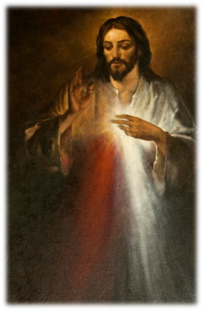
In the midst of the darkness, fear, and shame after the crucifixion and despite the locked doors, Jesus appeared among them (see Jn 20:19). Like Adam and Eve in the garden after the fall, the first inclination of the Apostles may have been to run and hide. They may have been thinking, “Oh, no! The ghost of the Master has come to punish us!” But Jesus puts them at ease as He immediately greets them with the comforting words, “Peace be with you.” Then, He shows them His pierced hands and side, and the disciples rejoice. He also breathes on them, saying, “Receive the Holy Spirit. If you forgive the sins of any, they are forgiven” (Jn 20:23). What’s God’s lesson here in the school of trust? He’s saying, “Even after you’ve abandoned me and have locked the doors of your heart because of fear, I come to you, not to punish you, but to give you my peace, forgiveness, and joy.” In summary, at his Resurrection, Jesus gives us what would later be called the Image of Divine Mercy, the image of his appearance to his disciples in the upper room. What’s there to be afraid of? “Jesus, I trust in you.”
Who’s Afraid of a Piece of Bread?
The Eucharist is the coming of the Lord in a humble form, even more humble than a little baby! Obedient to the words of the priest, he comes to us under the appearance of bread and wine. Who’s afraid of a piece of bread or a chalice of wine? And that bread and wine, which truly become his Body and Blood, make present his death on the Cross, where his Body and Blood were separated for us.
The Eucharist is the perfect lesson in God’s school of trust! How can we fear such a good and gracious God? How can we not trust in him? Yet, despite all these proofs of God’s love, goodness, and mercy, we still struggle with fear. We still have a hard time giving God our trust. And so, God’s school of trust continues in the history of the Church as the Holy Spirit tries to convince us of the truth about God that has been fully revealed in the first greatest story ever told.
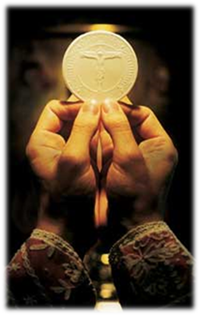
[1] Catechism of the Catholic Church, 397.
Now is the time of mercy (part 2)
Jansenism and the Sacred Heart
Remember we said that original sin left us with a distorted image of God and that His ‘school of trust’ was to bring us back to see Him as the loving and merciful God He is. And we responded well at first . . . to be honest God’s school of trust presented to us in Sacred Scripture, we almost always “get it.” In other words, to varying degrees, for at least the first millennium of Christianity, the faithful basically understood the message of God’s love and mercy.
But there’s one period in Church history when God’s school of trust, all His efforts to convince us of His love and goodness, did not seem to be working — people were not getting it. This terrible period in the Church’s history, which reached its high point in the 17th century, is that of the Jansenist heresy.
Jansenism made the spiritual life into a kind of puritanical olympics of painful penances and deprivations such that only the elite, self-denying, gold-medal winners get to receive God’s love. As for the rest of us losers, all that’s left is bitter despair as we nervously await the fiery wrath of a vengeful God. Jansenism became a problem for the faithful especially in Scotland where priests trained in France had been influenced by this heresy. If you want to know what Jansenism is like then imagine a church where the key words are justice, wrath, and punishment. Imagine a church where Adam and Eve were right to run and hide from God. If you can imagine that, then you can imagine Jansenism.
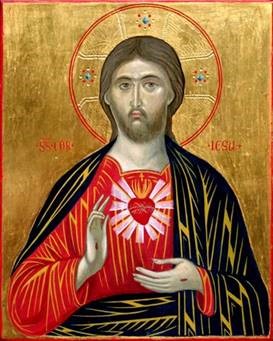
Counter-attack:
Saint Mary Margret and the Sacred Heart devotion
So truly, the whole sad scenario of Jansenism was breaking Jesus’ heart and led to one of the most dramatic events in the whole mystical tradition of the Catholic Church. Here’s what happened. On December 27, 1673, Jesus cast His gaze out on all of Europe, searching for a true friend on whom He could unburden some of His heartache and through whom He might finally convince people to believe in His tender love and mercy. Eventually, He found such a friend: a little nun in a convent in France named Sr. Margaret Mary. To this blessed soul, Jesus released an ocean of anguish as He disclosed His divine Heart. Appearing on the Cross, He said to her in a voice full of sadness and grief:
Behold, this Heart, that so deeply loves mankind, that it spared no means of proof — wearing itself out until it was utterly spent! This meets with scant appreciation from most of them; all I get back is ingratitude — witness their irreverence, their sacrileges, their coldness and contempt for me in this Sacrament of Love.
Saint Alphonsus
But God loves us so much He wasn’t going to give up on us, and so He once again recruited another valuable warrior: Saint Alphonsus Ligouri.
Saint Alphonsus contributed to God’s cause against Jansenism above all through his moral theology. He developed a merciful moral theology that became wildly popular as it spread through seminaries and parish rectories like a fire. Alphonsus’s teachings also encouraged laypeople to receive Jesus in the Eucharist more frequently. (Many people, scared away by Jansenist teaching, only received Communion once a year.)
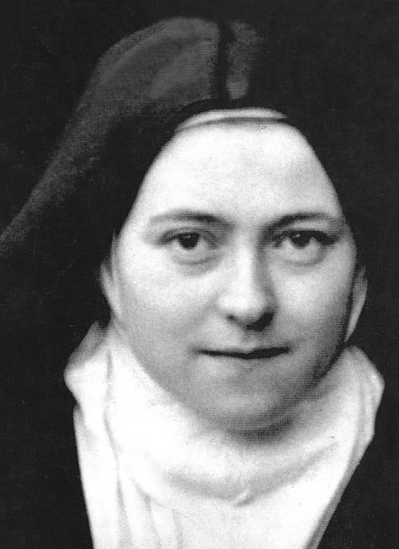
Saint Thérèse of Lisieux
By the end of the 18th century, many Catholics still remained fearful of God, focused on his justice, and confused by his love. This was a problem even in the convents, which became bastions of Jansenistic spirituality, especially in France. Yet it was in one of those very convents, amidst all the thorns and thistles, that a flower blossomed and bloomed, giving off a captivating fragrance that would open the hearts and minds of millions of people to the God of merciful love. Of course, I’m talking about St. Thérèse of Lisieux, the Little Flower, the little warrior for God against Jansenism.
It was her Little Way that brought Catholics back to the primacy of faith (over works) in the spiritual life. At its heart, the Little Way teaches us something well before it’s time, namely, that the “universal call to holiness” of Vatican II is real. Thérèse convinced “little souls,” as she called them, that they truly can become saints, not by relying on their own merits and works but by repenting of sin, showing mercy to others, and trusting in the infinite mercy of God who can do all things, even make us modern sinners into great saints. Thérèse almost single-handedly reintroduced the Church into the way of confidence and love, God’s school of trust. But the story does not end there. God was still leading the Church through his school of trust, and the Church’s most important lesson would soon begin in the relatively small, often-overlooked country of Poland. That amazing lesson would become the second greatest story ever told. But that’s for next time . . .
Now is the time of mercy (part 3)
The second greatest story unfolds as the most violent war in human history is getting ready to explode, in the country that would see the largest number of its citizens slaughtered in that war, and during the bloodiest century in human history. Phew! That’s heavy — and it’s fitting. After all, during a time of incredible evil, we need an incredibly powerful story to remind us of the goodness of God. In the darkest era, we need the brightest light to keep us from giving up and losing heart. In the time of greatest desperation and despair, we need a most convincing message and witness to hope. That’s what God has been up to. That’s why, in our time, he’s giving us the second greatest story ever told. It’s because we need it.
Again, and again, until we get it Remember when after God rescued the Israelites from slavery? What happened? The Israelites slapped God in the face and showed their greatest ingratitude. And what did God do in the midst of that darkness? He dramatically revealed his mercy, “The Lord, the Lord, a God merciful and gracious, slow to anger, and abounding in mercy and faithfulness, keeping merciful love for thousands, forgiving iniquity and transgression and sin” (Ex 34:6-7). And remember when Jansenism was destroying God’s school of trust and causing so much horrible heartache in the Church? What did God do then? Again, He did something dramatic. He revealed his Sacred Heart through St. Margaret Mary in France. Well, now the second greatest story begins with something just as dramatic.
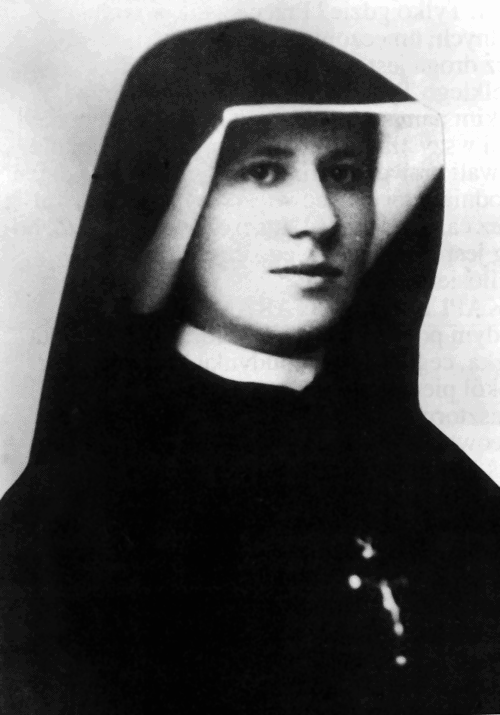
In the face of some of the greatest darkness in human history, God reveals His Merciful Heart, His Divine Mercy, through St. Faustina Kowalska in Poland. Really. He did. We shouldn’t be surprised that God acts in history. We shouldn’t be surprised that He acts dramatically during the darkest of times.
Now, straight off, I want to address something that may be bothering some of you after reading about personal revelation. There are some people who get really uncomfortable with the idea that God reveals Himself or speaks to people. I don’t know why this is the case. He did it in the Old Testament. He did it in the New Testament. He continues to do it now. Maybe the problem is with “false prophets,” those people who tell everyone that God is speaking to them but who are really just being deceived, hungering for attention, or unbalanced. Don’t worry. Saint Faustina was not being deceived, nor hungering for attention, and she certainly wasn’t unbalanced. She’s a saint, a great saint.
God used Saint Faustina as a prophet, but don’t get hung up on the word “prophet.” A prophet is someone who has had a powerful experience of God that they are then called to share at a given time for the strengthening of other people’s faith, hope, and love.
St. Thérèse was a prophet. Yes, she is, too. In fact, she represents part of a whole prophetic stream in the life of the Church. In other words, sometimes God has a message that’s so important that he uses not just one, not two, but a whole series of prophets to make sure people get the chance to hear the message. Before, we saw that the modern “stream of mercy” began with St. Margaret Mary and the Sacred Heart, ran through St. Alphonsus de Liguori, and then into St. Thérèse of Lisieux. Now, we see that it goes on to Saints Faustina and John Paul II.
The heart of the message: TRUST! It’s part of the Sacred Heart devotion, “Sacred Heart of Jesus, I place my trust in Thee.” It’s a key part of St. Alphonsus’s moral theology, to trust in the merciful God. It’s at the centre of St. Thérèse’s Little Way of humble confidence. Trust is the main theme of the message of Divine Mercy given to the world though St. Faustina.
Clearly, He wants to continue His school of trust and heal the distorted image we have of Him as a result of the fall.
Early Spreading of the Message.
St. Faustina died at the age of 33 on October 5, 1938. Less than a year later, on September 1, 1939, the terrible war that Faustina had foreseen and warned others about came crashing down on Poland, beginning with the Nazi invasion and occupation. It’s hard to overstate the death, destruction, and devastation that World War II inflicted on Poland. Out of a pre-war population of 35 million people, six million of its citizens were killed in combat or, in most cases, murdered outright. That is an 18-percent casualty rate, the highest of any country during World War II.
During this time of hell on earth, a circulation of pamphlets and prayer-cards bearing the Divine Mercy Image, Chaplet, Litany, and Novena gave comfort to countless numbers of brutalized Polish souls. That the message spread throughout Poland on the cusp of the war is largely thanks to the efforts of St. Faustina’s spiritual director, Blessed Fr. Michael Sopocko, who personally funded this apostolate of mercy.
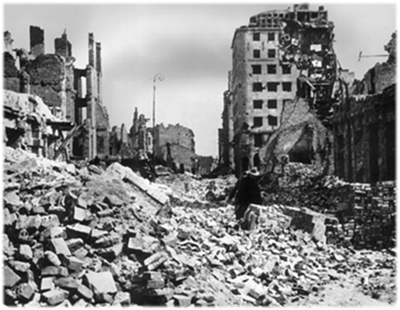
Father Jarzebowski’s ship pulled into the Japanese port on March 13, 1941. Soon thereafter, he met up with the Franciscans who had aided his passage. Perhaps because of his extraordinary joy and amazing story, they invited him to give them a retreat. He did so at their Mugenzai no Sono (Garden of the Immaculate) Monastery in Nagasaki. Of course, the theme of the retreat was Divine Mercy. And what a retreat it must have been! By that point in his trip, Fr. Jarzebowski’s gratitude to Jesus, The Divine Mercy, could hardly be contained.
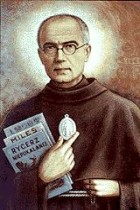
Unfortunately, the monastery’s founder, St. Maximilian Kolbe, couldn’t attend. He was in the midst of another sort of spiritual exercise, this one at the Auschwitz concentration camp. There, five months after Jarzebowski’s arrival in Japan, Kolbe would not be preaching mercy but rather living it to the full — he’d be freely giving up his life that another prisoner might live.
Now is the time of mercy! (Part 4)
On his arrival at the Marian’s religious house in Washington, Fr. Jarzebowski knew that the Merciful Saviour had brought him safely home to his brothers in America — and he kept his promise to Fr. Sopocko. He and the Marians of the Immaculate Conception, taking advantage of the environment of freedom in the United States, spread the Divine Mercy message throughout the country.
The Ban.
During the war years, many people received great graces and comfort from the Divine Mercy booklets and prayer-cards that Fr. Sopocko had distributed. Then, after the war, as the testimonies to these graces spread, more and more people wanted to get the Divine Mercy literature for themselves. People were still suffering the effects of the war, and the message of Divine Mercy brought them great comfort and amazing graces. However, as the devotion grew in popularity, the errors in the literature, due to inaccurate copying and translation, were brought to the attention of various priests and theologians who then wrote to the Holy Office in Rome (the present-day Congregation for the Doctrine of the Faith). After getting several of these complaints and then going through the literature, the Holy Office prepared a decree in 1958 that would have forever prohibited the Divine Mercy devotion as presented by Sr. Faustina. However, because the Pope at the time, Pius XII, was so ill, the Holy Office didn’t submit this decree until after his death, slipping it under a large pile of papers for the next pope to deal with.
The next Pope, St. John XXIII, was unexpectedly elected after 11 ballots at the relatively old age of 76. The faithful called him “Good Pope John” and loved him like a grandfather. Many of the Vatican bureaucrats surely wanted him to act like a grandfatherly Pope. In other words, they hoped he’d just go into semi-retirement mode as a kind of interim or caretaker Pope and keep business as usual until the next papal election.
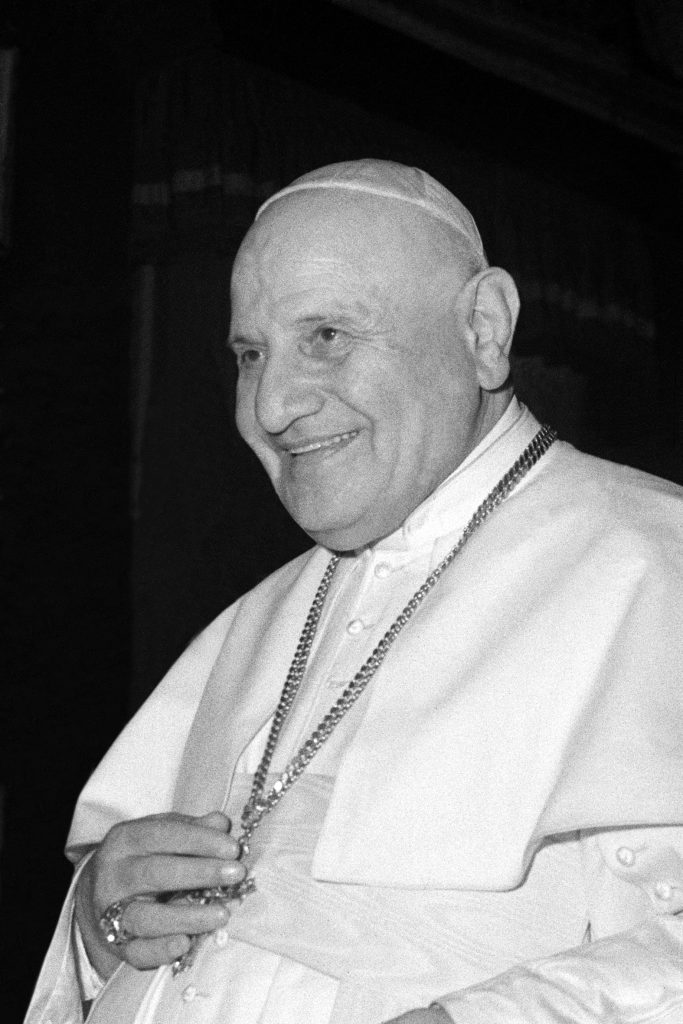
Having worked at the Vatican before being elected Pope, John XXIII knew what “business as usual” meant. For instance, he was well aware that certain members of the curia would sometimes slip important papers at the bottom of piles with the hope that a tired, overworked Pope would just glance over them and rubber stamp his approval. Well, when John XXIII first arrived at his office and saw his new desk with the tall pile of papers awaiting his signature, he proceeded to sit down, make the Sign of the Cross, and flip the whole pile over! Thus, the very first thing he dealt with as Pope was the decree that had been slipped in at the bottom of the pile, the decree prepared by the Holy Office regarding Sr. Faustina, the decree that would have forever forbidden the spread of the Divine Mercy devotion and the hanging of Divine Mercy Images in the churches. According to one of his personal secretaries, the Pope read this decree carefully, shook his head, and said, “No, no, no. This must be looked into further. The bishops of Poland need to be consulted.” But they couldn’t be consulted because of the religious suppression under the Communists. So, instead of a decree forever forbidding the message, Pope John only approved a notification that prohibited “spreading of the devotion to Sr. Faustina, pending clarification of [the Vatican’s] concerns.” That notification was published on March 6, 1959.
For many, the Holy Office’s notification was met with great surprise: “How could something that has borne so much fruit be banned?” For anyone who might have read St. Faustina’s Diary, however, this notification shouldn’t have come as a surprise. After all, Faustina had clearly prophesied that such a thing would happen.
There will come a time when this work, which God is demanding so very much, will be as though utterly undone. And then God will act with great power, which will give evidence of its authenticity.
[It] will be a new splendour for the Church, although it has been dormant in it from long ago. … When this triumph comes, we shall already have entered the new life in which there is no suffering. But before this, your soul [Fr. Sopocko] will be surfeited with bitterness at the sight of the destruction of your efforts.
Lifting of the Ban.
Today, we realize that the ban was eventually lifted, but how did it happen? First and foremost, we should probably thank the Polish laity, who can be quite determined (and stubborn) when it comes to pursuing God’s glory. After the announcement of the ban, they never let up on giving the poor Archbishop of Sr. Faustina’s Archdiocese of Krakow a piece of their mind.
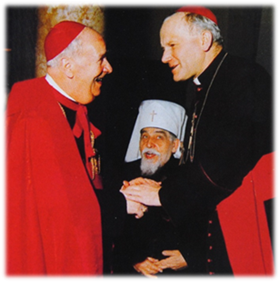
Karol Wojtyła was in Rome for the last session of Vatican II. As he was exiting St. Peter’s Basilica in the recessional procession after the opening Mass, he was speaking with his friend, Monsignor Andrew Deskur, who had introduced him to the Divine Mercy message when the two were in the seminary together. Suddenly, the two of them spotted Cardinal Ottoviani, who was the prefect of the Holy Office and knew the matter of Faustina very well.
The two friends went up to the Cardinal and asked him whether it were still possible to begin the process of Faustina’s beatification given the fact of the notification of prohibition from Ottoviani’s office. Ottoviani replied, “What? You haven’t started it yet? Hurry and start it before the witnesses die.” That’s all the encouragement Wojtyła needed.
In January of 1968, by a decree of the Sacred Congregation of the Causes of Saints, the process of beatification of the Servant of God Sr. Faustina Kowalska was formally inaugurated.
Deeper knowledge and appreciation of Faustina by Vatican officials eventually led to what took place on April 15, 1978: In response to inquiries from the Marian Fathers of the Immaculate Conception in Stockbridge and from prelates in Poland, such as Cardinal Wojtyła, regarding the “Notification” of 1959 (which effectively banned the spreading of the message of Divine Mercy through Sr. Faustina), the Sacred Congregation for the Canonization of Saints issued a new “Notification”. By this document, to the great rejoicing of the faithful, the Vatican lifted the ban on spreading the message of Divine Mercy through Sr. Faustina. Then, less than six months after this momentous document was issued, the Cardinal Archbishop who had done so much behind-the-scenes work to accomplish this task was elected Pope John Paul II.
With his election, the “new splendour” in the Church, prophesied by Sr. Faustina, began. Let’s close this part by commenting on coincidences. Pope John Paul II once said that “in the designs of providence,” there aren’t any. It’s no surprise, then, that he clearly recognized the hand of God’s providence in the fact that his election as Pope came just six months after the lifting of the ban on the message of Divine Mercy.
Now is the time of mercy! (Part 5)
Arguably, the deepest insight into John Paul’s “pastoral soul” is revealed in Dives in Misericordia. It comes in the famous last chapter of the encyclical, which is a sustained meditation on the importance of calling out for God’s mercy even “with loud cries.” The Pope says that “These ‘loud cries’ [for mercy] should be the mark of the Church of our times.” Why in our times? Because, again, we are in such great need of mercy!
What is mercy? John Paul II defines it in Dives in Misericordia as “love’s second name,” as “the specific manner in which love is revealed and effected in the face of the reality of the evil that is in the world, affecting and besieging man.” In other words, mercy is love when it meets poverty, weakness, brokenness, and sin. It’s the power of love to bring good out of such evil.
It is precisely because of the evils of the modern world, John Paul II saw the message of Divine Mercy as the special task that God had entrusted to him for our time.
Mercy Sunday During the Year of Mercy.
While Saint John Paul II proclaimed mercy throughout his whole pontificate, a particularly special moment of grace happened on Divine Mercy Sunday during the Great Jubilee Year of the Incarnation, 2000, the Year of Mercy. On that Divine Mercy Sunday of the Year of Mercy, John Paul II canonized St. Faustina as the first saint of the new millennium:
“By this act, I intend today to pass on this message to the third millennium.”
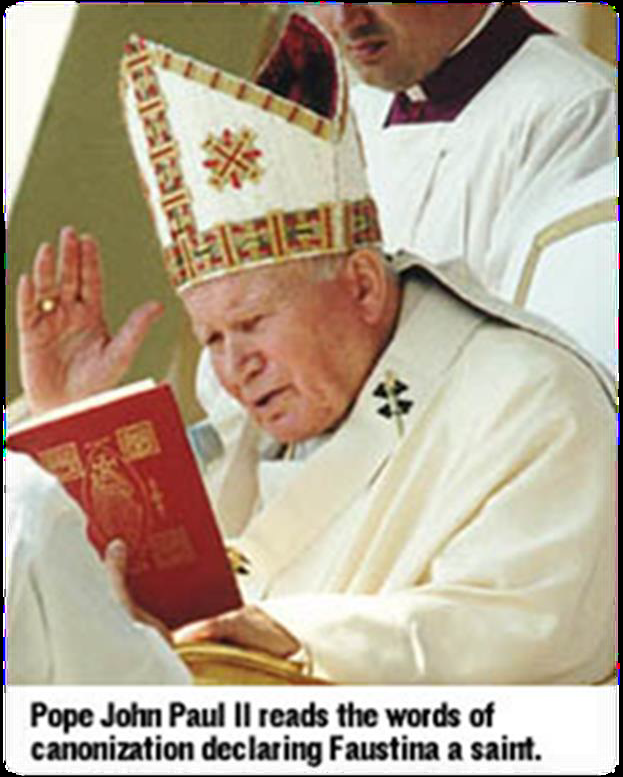
“By this act, I intend today to pass on this message to the third millennium.”
Now, what message was he talking about? The message of God’s merciful love: a message that will help all people discover, he said, “the true face of God,” a message that overcomes the false image of God that results from original sin, a message that gets to the heart of God’s school of trust. John Paul then ended his homily with a moving prayer to the new saint who, for the third time, he calls a “gift of God” to our time.
Saint Faustina seems to have heard this prayer not only from heaven but, one might say, even during her own lifetime! I say this because it appears that Faustina experienced a mystical vision of that great Divine Mercy Sunday of the year 2000. To help us understand how profoundly important that day was for the Church and the world, let’s read Faustina’s own description of that vision:
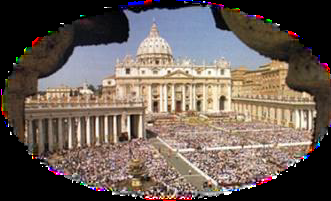
Suddenly, God’s presence took hold of me, and at once I saw myself in Rome … . And I took part in the solemn celebration simultaneously here [in the convent in Krakow] and in Rome, for the celebration was so closely connected with Rome that,
even as I write, I cannot distinguish the two but I am writing it down as I saw it. . . .
The crowd was so enormous that the eye could not take it all in. Everyone was participating in the celebrations with great joy, and many of them obtained what they desired. The same celebration was held in Rome, in a beautiful church, and the Holy Father, with all the clergy, was celebrating this Feast, and then suddenly I saw Saint Peter, who stood between the altar and the Holy Father. I could not hear what Saint Peter said but I saw that the Holy Father understood his words. Then suddenly, I saw how the two rays, as painted in the image, issued from the Host and spread over the whole world. This lasted only a moment, but it seemed as though it had lasted all day … and the whole day abounded in joy. Then suddenly I saw on our altar the living Lord Jesus, just as He is depicted in the image [of Divine Mercy]. … Jesus looked with great kindness and joy at the Holy Father, at certain priests, at the entire clergy, at the people and at our Congregation. Then, in an instant, I was caught up to stand near Jesus, and I stood on the altar next to the Lord Jesus, and my spirit was filled with a happiness so great that I am unable to comprehend it or write about it. A profound peace as well as repose filled my soul. Jesus bent toward me and said with great kindness, What is it you desire, My daughter? And I answered, “I desire worship and glory be given to Your mercy.” I already am receiving worship by the institution and celebration of this Feast; what else do you desire? I then looked at the immense crowd worshiping The Divine Mercy and I said to the Lord, “Jesus, bless all those who are gathered to give glory to you and to venerate Your infinite mercy.” Jesus made a sign of the cross with His hand, and this blessing was reflected in the souls like a flash of light. My spirit was engulfed in His love. … I am immensely happy. … I am happy with everything You give me.
First, notice that St. Peter appears in Faustina’s vision and speaks with the Holy Father, who “understood” what the Apostle was saying. This is significant, because it seems to indicate that heaven was specially united with and authoritatively confirming this momentous occasion for the Church and the world.
Second, notice that in Faustina’s vision, the celebration in Rome was somehow simultaneously experienced at her convent in Kraków. She writes it as she saw it, but couldn’t explain how the two could be experienced at the same time. Well, the organizers of the Divine Mercy Sunday 2000 event had set up giant TV screens in St. Peter’s Square as well as at the sisters’ convent in Krakow. Those screens did simultaneously broadcast the event such that the sisters in Kraków could see the people in Rome and the people in Rome could see the sisters in Krakow, which is exactly what Faustina describes in her vision. It seems that Faustina got a glimpse of modern technology!
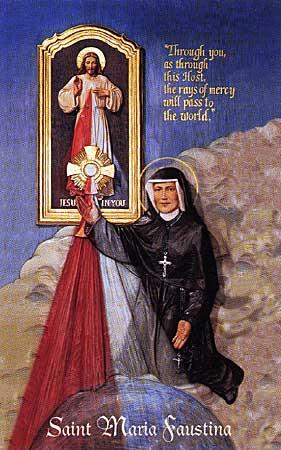
Third, notice the conversation between Jesus and Faustina. Jesus asks her what she desires. She replies that she desires that worship and glory be given to His mercy. He responds, “I already am receiving worship by the institution and celebration of this Feast.”
Jesus’ words here imply that the Feast of Divine Mercy had already been instituted. But when did that happen? It happened during the homily Pope John Paul gave at the canonization Mass! That was perhaps the greatest gift of the Great Jubilee Year.
Fourth, notice the joy and happiness that Faustina describes in her vision. She says that everyone was participating in the celebration “with great joy,” that “the day abounded with joy,” that Jesus “looked with great kindness and joy” on the people, and that Faustina herself was filled with an incomprehensible happiness and was “immensely happy.”
At the banquet following the canonization ceremony, Pope John Paul II shared with the doctor who had investigated the canonization miracle, Dr. Valentin Fuster, a startling revelation. He said to him, “Today is the happiest day of my life.” Wow! But why was there so much joy? Well, for one, the greatest joy comes in our lives when we have accomplished our God-given mission. John Paul II, who believed that divine providence had assigned to him the task of spreading the message of Divine Mercy, accomplished his mission on that day. He canonized St. Faustina, passed
her message on to the new millennium, and declared that the Second Sunday of Easter was to be celebrated as Divine Mercy Sunday, in fulfilment of the Lord’s desires.
When we realize all this, when we see the true face of God, that He is love and mercy itself, that His love is more powerful than evil, and that He is pouring it out in a unprecedented way in our time, we cannot help but be filled with indescribable happiness and joy.
Now is the time of mercy (part 6)
By Divine Mercy Sunday, 2000, it could have seemed enough – Mission accomplished. Now, John Paul could just ease into a well-deserved retirement. Right? Wrong. He continued to lead the Church even more deeply into the mystery of mercy. He did so probably most profoundly in 2002 when he dedicated the Shrine of Divine Mercy in Kraków-Łagiewniki, Poland, and entrusted the whole world to Divine Mercy. That shrine was particularly significant to John Paul. During the war, while he was working at the Solvay rock quarry and studying for the priesthood in secret, he learned about the mystic, Sr. Faustina. Her message deeply moved the young Karol Wojtyła, and so, he often stopped by her community’s chapel on his way back to the seminary from a long day of hard work. With tears in his eyes, John Paul reminisced about this during some off-the-cuff remarks at the end of the Mass for the Shrine’s dedication. At the end of this solemn liturgy, I desire to say that many of my personal memories are tied to this place. During the Nazi occupation, when I was working in the Solvay factory near here, I used to come here. Even now I recall the street that goes from Borek Fałęcki to Dębniki that I took every day going to work on the different turns with the wooden shoes on my feet. They’re the shoes that we used to wear then. How was it possible to imagine that one day the man with the wooden shoes would consecrate the Basilica of the Divine Mercy at Łagiewniki of Krakow? In my opinion, the words of mercy that John Paul spoke during his homily of dedication were some of the most profound of his entire pontificate. You might say he chose the best for last.
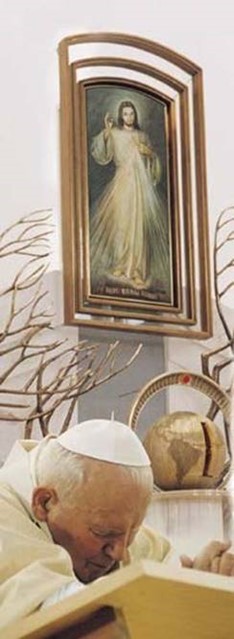
For, indeed, this was his last pilgrimage to his beloved homeland, and he knew it. Many had advised him not to make the trip, because of his ill health, which he knew was getting worse. But he wanted to go. He had a message to give. He had a spiritual work to “finish.” Let’s read the homily’s stirring conclusion now, which includes an act of entrustment of the whole world to Divine Mercy: How greatly today’s world needs God’s mercy! . . . Today, therefore, in this Shine, I wish solemnly to entrust the world to Divine Mercy. I do so with the burning desire that the message of God’s merciful love, proclaimed here through Saint Faustina, may be made known to all the peoples of the earth and fill their hearts with hope. May this message radiate from this place to our beloved homeland and throughout the world. May the binding promise of the Lord Jesus be fulfilled: from here there must go forth “the spark which will prepare the world for [the Lord’s] final coming” (Diary, 1732). This spark needs to be lighted by the grace of God. This fire of mercy needs to be passed on to the world. In the mercy of God the world will find peace and mankind will find happiness!
Divine Confirmation, 2005
Even after hearing John Paul’s powerful words of mercy at the shrine in Kraków in 2002, many clergy still did not believe that “now is the time of mercy.” They felt that all this Divine Mercy stuff simply stemmed from the fact that John Paul was Polish. They’d imply that in his old age, the Pope was just becoming more and more (unreasonably) obsessed with a Polish devotion. They pointed out, for instance, that the Image of Divine Mercy has red and white (pale) rays and would comment, “Look, those are the colours of the Polish flag. This is just a case of Polish nationalism. We don’t need to listen to all this stuff about Divine Mercy.” In the face of such dismissive attitudes, God himself did something dramatic to confirm that now really is the time of mercy.
I should mention that I have a pretty melancholic temperament. In other words, it doesn’t take much to get me down-in-the-dumps and depressed. So, when I would reflect on the amazing life of John Paul II, I’d think to myself, “There can be no fitting end to such an amazing life. No matter what happens, it’s going to be anti-climactic. So, if the Pope just dies of a heart attack in the bath, I’m going to be so depressed. And because that’s probably what’s going to happen – some mundane and uneventful demise – I might as well get depressed about it before-hand.” And so I would. Bizarre? Yes. But that was me. Well, when April 2, 2005, rolled around, and John Paul the Great breathed his last, it was the most beautiful, fitting, and perfect ending to his amazing life that I ever could have imagined . . . almost. What do I mean by “almost”? I mean that April 2, 2005, was the day before Divine Mercy Sunday. He was so close! Why couldn’t he have held on for just one more day? If he’d have died on Divine Mercy Sunday, then it would have been the perfect ending! It truly would have been the second greatest story ever. But the ending ruined it. So, of course, I got depressed – but not for long. I soon learned that it was the perfect ending.
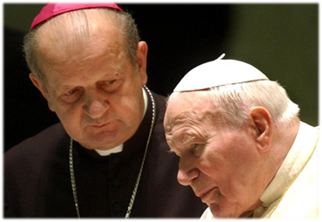
Let me explain. John Paul II had a long-serving personal secretary, Archbishop Stanisław Dziwisz, who was in the room with the Pope during his final hours. Dziwisz reports that on the night of April 2, as John Paul was nearing his death, he, Dziwisz, suddenly felt a strong imperative in his heart, telling him to celebrate Mass right away. Obediently, Dziwisz began to set up for Mass right then and there in John Paul’s room, by his bedside. As he was setting up for Mass, Dziwisz realized that it was well after sunset on a Saturday, and so he set up the vigil Mass for the Sunday, which of course, was the Sunday of Divine Mercy.
Dziwisz celebrated the Mass as the Pope was going in and out of consciousness. At the time of Communion, John Paul was able to receive the Eucharist, doing so through a droplet of the Precious Blood. Less than half an hour after receiving the Lord, John Paul went home to his eternal reward.
Although he died on Saturday, April 2, 2005, the vigil of Divine Mercy Sunday, John Paul had already prepared his Regina Caeli message for Divine Mercy Sunday itself. Obviously, he couldn’t give that message – he had died the night before. However, an archbishop of the Vatican, Leonardo Sandri, read John Paul’s final message before the people gathered in St. Peter’s Square.
These are the final words of Saint John Paul the Great:
As a gift to humanity, which sometimes seems bewildered and overwhelmed by the power of evil, selfishness, and fear, the Risen Lord offers his love that pardons, reconciles, and reopens hearts to love. It is a love that converts hearts and gives peace. How much the world needs to understand and accept Divine Mercy! Lord, . . . we believe in you and confidently repeat to you today: Jesus, I trust in you, have mercy on us and on the whole world.
Once again, wow! John Paul’s final words to humanity repeat the main message of his life.
John Paul’s last words, together with some of his first words, provide fitting “bookends” to the second greatest story ever told. The first bookend is based on the key words of his first papal homily: “Be not afraid!” The last bookend is drawn from the key words of his final message: “Jesus, I trust in you!” Mixing metaphors, here, you might say these are really two sides of the same coin. How are we to “be not afraid”? The answer is simple: Trust in Jesus. “Jesus, I trust in you.” How fitting it is that God’s school of trust, that long lesson through the ages, ends with the second greatest story pointing us back to the centre of the first greatest story – Jesus – and a call to trust in him. That’s really everything that God has been trying to get us to do since the fall. He just wants us to trust in him. His message for the “end times” is really the same message from the beginning of time to fallen humanity: Trust in me! I am Love and Mercy itself. Even with the testimony of the such great mercy saints as Margaret Mary Alacoque and Thérèse of Lisieux, even with the amazing drama of the second greatest story ever told, which is based on the remarkable lives of Saints Faustina Kowalska and John Paul II, we still have a hard time trusting. So what do we do now? Well, there’s actually more to the story. (Believe it or not, the second greatest story gets even better.)
Now is the time of mercy! (Part 7)
If what I say to you is done, many souls will be saved and there will be peace.
~ Our Lady of Fatima
I’ve often thought about what other story might be a contender for the title, “the second greatest story ever told.” If I’m claiming that this story, the story surrounding John Paul II as a prophet of mercy, is the second greatest story ever told, then I’d better have done my homework properly.
Well, after doing my homework, I believe I’ve found a story that gives John Paul’s story a run for the money: It’s the story of Our Lady of Fatima, and its amazingly powerful.
It really is an amazing story. And what’s even more remarkable is that it’s actually part of the second greatest story ever told.
Of course, you’ve probably heard much of the story of Fatima before, but probably not the key connections, and that’s the part, I bet, that will bowl you over.
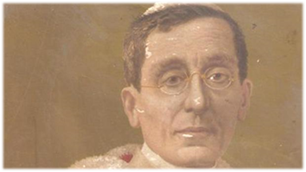
Poor Pope Benedict XV
In a certain sense, the story of Fatima begins with Pope Benedict XV. Elected Pope on September 3, 1914, just over a month after the beginning of World War I, Benedict literally had the weight of the world on his shoulders.
Immediately after his election, Benedict declared Vatican neutrality in the war, and from that position, laboured to negotiate peace with the warring countries. Unfortunately, both sides viewed him with suspicion. Despite the unprecedented horrors of “The Great War,” as it was called at the time, despite his failed efforts for peace, Pope Benedict didn’t get discouraged. Why not? Because he had a secret weapon. Benedict’s secret weapon was not the poison gas that suffocated soldiers in the trenches on the Western Front. It wasn’t the merciless spray of machine gun bullets that tore into the flesh of charging infantry. Nor was it the newly invented massive metal tanks that crushed men into the blood-soaked earth. Rather, his secret weapon was she who crushes the proud head of Satan: the Blessed Virgin Mary. More specifically, Pope Benedict decided to invite all the sons and daughters of the Church to pray a solemn novena to Mary, our “Mother of Mercy,” asking her for peace.
On the eighth day of the novena, May 13, 1917, the Pope’s plea for peace was finally answered — not by a prime minister, president, or king, but rather, by a queen, the Queen of Peace herself.
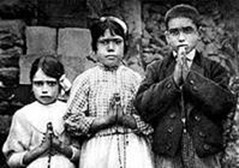
Our Lady Appears
She showed up at a place in Europe that was about as far away as possible from the horrors of the war. She appeared near the town of Fatima, Portugal: she went to three simple shepherd children: Lucia, Jacinta and Francisco.
When the beautiful Lady appeared to the children in the Cova, she asked them to return on the 13th of each month. During each apparition, Mary asked the children to pray the Rosary daily for world peace and to do penance for sinners, who had no one to pray for them.
Among the six apparitions from May to October, those of July and October were particularly important and deserve our special attention as part of “the second greatest story ever told.”
July 13, 1917: Three Secrets
The core of the July 13th apparition can be divided into three parts or “secrets.” (They were called “secrets,” because Mary didn’t want them to be revealed right away.)
The First Secret. The First Secret helps us understand why Our Lady of Fatima so often appeared to the children looking serious and sad. This secret consisted of a terrible vision of hell that Mary revealed to the three children. This vision of hell had a profound effect on the children. They became more serious and their hearts were filled with a burning zeal to save sinners by praying and making sacrifices for them. As one contemporary saint, Thérèse of Lisieux, put it, “Souls are being lost like flakes of snow [on a winter’s day], and Jesus weeps.”[1] Yes. Jesus weeps, Mary weeps, and we also should weep. But as we’ve learned earlier, our situation is not hopeless, the weeping need not lead to despair. In fact, there’s good news: God is not outdone by evil, and as we learned earlier, he is offering unprecedentedly great graces in this our time, which, in fact, is the time of mercy.
The Second Secret. The Second Secret explicitly points to future events of the second greatest story ever told, which involves World War II and Communism. What did Our Lady say:
First, Our Lady says that the war (World War I) will end, and it did, in fact, end the following year.
Second, she warned of a “worse” war that would break out during the pontificate of Pope Pius XI. That war, World War II, was certainly worse than World War I on account of the number of people who were killed (50 million to 20 million, respectively), on account of the fact that God’s chosen people, the Jews, were nearly annihilated in Europe, and on account of the high ratio of civilian to military deaths.
Pope Pius XI died on February 10, 1939, and while many people would say that World War II started on September 1, 1939, with the German invasion of Poland, the war began not with the German aggression against Poland but against Austria when, on March 12, 1938, Nazi Germany annexed Austria, occupying it with troops.
Third, Our Lady mentioned “a night illumined by an unknown light.” Well, on January 25 and 26, 1938, an extraordinary, five-hour-long aurora borealis lit up the night skies of Europe and North America. Lucia, who, by then, was Sr. Lucia, interpreted this light as the sign that the war would soon begin. Recall that, for her, the outbreak of the war began with the annexation of Austria, which took place less than two months after the January aurora borealis.
Fourth, Our Lady speaks of a divine chastisement because of the earth’s crimes that will include war, famine, and persecution. Of course, we all know about the horrors of World War II, the “worse war” that Mary spoke of, which surely included famine and persecution of the Church. But she is also referring to the great suffering that would be caused by the Soviet Union, led by Russia. She makes this point explicit when she continues, saying, “If my requests are heeded, Russia will be converted, and there will be peace; if not, she will spread her errors throughout the world, causing wars and persecutions of the Church.”
We who are living in the third Christian millennium can clearly see the fulfilment of the “Russia” prophecy. But what about the people who were living in July of 1917? What would they have thought? I suggest that they likely would have been highly sceptical of such a prophecy. First of all, Russia at the time was still known as “Holy Russia,” because of the deep piety of the people, who practiced Russian Orthodox Christianity. So, what sense did it make to speak of Russia’s “conversion”? Second of all, Russia was still thought of as “Poor Russia,” which was far behind the economically and technologically advanced countries of Western Europe. How could such a second-rate power influence the world with her errors? In July of 1917, this all seemed highly unlikely, which shows all the more the remarkable nature of the Fatima prophecy.
Fifth, and most importantly, Our Lady said that all these horrors could be prevented by turning to her Immaculate Heart. In every one of the six apparitions, Our Lady emphasized the importance of praying the Rosary daily for world peace, even revealing herself in the last apparition as “the Lady of the Rosary.” Later I’ll talk about the connection between the Immaculate Heart of Mary and the Sacred Heart. But first, the Third Secret.
The Third Secret. The Third Secret, like the Second, points to future events. This time, however, the future events are not spoken of by Our Lady, but, rather, they’re shown to the children in a prophetic vision. It is widely accepted that this prophetic vision, which, according to the Vatican, should be understood in a “symbolic key,”[2] refers primarily to the events that have occurred during the Second World War and Cold War. It paints a symbolic picture of the suffering of the Church in the midst of those wars, a suffering that happened because the directives of Our Lady of Fatima were not sufficiently followed.
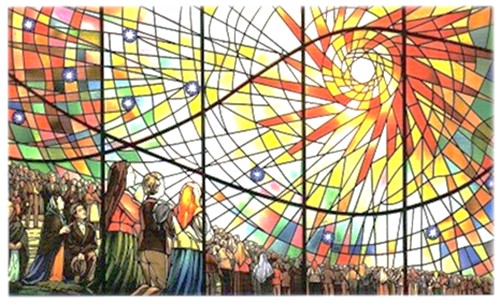
October 13, 1917: the Miracle of the Sun
What is known as the Miracle of the Sun came as a gift from Our Lady to confirm the message of Fatima in a dramatic way. And such a miracle was important. After all, it would take decades before the prophecies of Our Lady of Fatima would be fulfilled, but the Miracle of the Sun was immediate and left little room for doubt.
As part of the second greatest story, God worked one of the most awesome and dramatic public miracles in the history of the Church to confirm the story. Our Lady made her promise and she had kept her promise: a miracle “for all to see and believe,” and what a remarkable miracle it was!